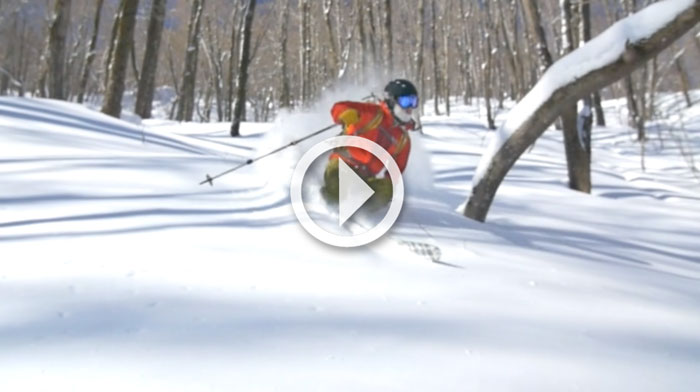- Death Valley’s Battle With Climate Extremes - 01/01/2024
- The Future of Homewood - 12/05/2023
- Kula Cloth - 10/18/2023
Joanne Schwartz’s lifetime of adventure
By Leonie Sherman
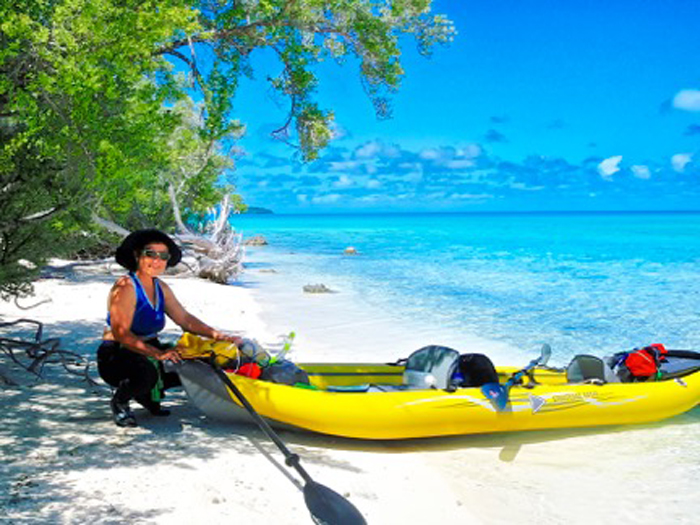
Kayaking at Aitutaki Atoll, Cook Islands. Photo: Doug Schwartz.
Four foot ten with sparkling eyes and an effervescent smile, Joanne Schwartz was the first person to leave the campground every morning and the last person to return. While I was sitting on a deserted beach playing tin whistle, she was scaling the second highest mountain on the island, a 12-mile hike with fifteen hundred feet of elevation gain. The next day she took off for a 16-mile ramble in search of wildflowers. Over dinner she shared stories of kayaking the South Pacific and an expedition to Mexico’s Copper Canyon. I crawled off to my tent while she was still laughing with the boys. She’s 70 years old.
“Who is this ‘Little Old Lady’ kicking all our asses and making it look fun?” we asked each other the next morning as she shouldered her pack and strolled off to the east.
Turns out her fitness and enthusiasm are the result of a lifetime of exploration and discipline. She’s not drinking a magic elixir, but she has a recipe for living a bold wild life.
Joanne’s curiosity about the natural world began as a child but blossomed in 1985, when she posted a note at an REI looking for local kayaking companions who could help her develop hard skills. Six people responded. Five of them were interested in having a good time on the ocean. One was interested in the intricacies of kayak surfing, how to roll and stay safe in foul conditions. His name was Doug and while learning to navigate tricky currents and rocky landings together they fell in love.
They began embarking on kayaking expeditions around the world. REI and other venues were proud to host slide shows about their trips: Sea Kayaking Odyssey, Kayaking Tonga, Fiji: Culture By Kayak, Paddling the Southwest, Trip Planning, Paddling the Tropics, Kayak Camping and others. After every show they were mobbed by people who wanted to join them on their next adventure, but few had the necessary skills. So in 1987 they started a kayak guiding service called Southwind. For twenty years they taught safety skills, led expeditions, and rented and sold kayaks to a growing fan club. By the time they sold their company and retired in 2006 they’d inspired and empowered thousands.
One day I convinced Joanne to sit down long enough to share some of the wisdom she’s gained from over five decades of pursuing her passions.
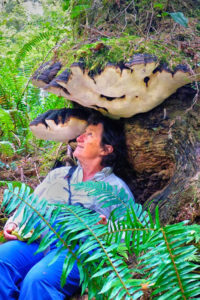
Giant Ganoderma mushroom, Prairie Creek Redwoods State Park, CA. Photo: Doug Schwartz.
What sparked your lifetime pursuit of wilderness adventures?
When I was a kid my family didn’t do outdoor adventures. We’d go to the beach and have a barbecue in a barbecue pit. But in college I studied chemistry and the guys I was studying with started taking me on backpacking trips. I saw things I’d never seen before, experienced the world in a way I never had. I started opening up to the natural world and that love has grown every day since then. Other girls in the dorm were into dating and fancy clothes, but adventuring and being outdoors captured my imagination and my heart.
How do you maintain it all — your drive, your fitness, your focus?
A lot of people are much more interested in having fun than building skills. Doug and I work really hard at staying competent, which is skill-based. Over the decades we’ve developed really good skills for kayaking, backpacking, snowboarding, mountain biking and photography, as well as having competence with wilderness medicine. That focus makes us who we are; it makes the lives we’ve led possible.
To stay physically fit I do four or five tough strength and cardio workouts at the gym every week. Staying mentally fit is an active pursuit, just like physical strength. That means getting a good night’s sleep, doing all sorts of meditations and cognitive approaches to dealing with things that are stressors, keeping myself grounded so I can handle the issues that life throws at all of us.
Doug and I are also really committed to having quality gear and maintaining it regularly, so we know the gear won’t be a limiting factor in our adventures. That’s essential to being free.
How do you stay so stoked?
I get most excited about citizen science and environmental conservation projects. For example, Doug and I spent four weeks in Montana, censusing nesting Common Loons in twenty alpine lakes. And we spent over a month in Northern California’s redwoods GPS-mapping boundaries of the old growth forests. We came up with new data that will help redefine management plans for those areas. These projects could be on our own or could be volunteering with non-profits like Earthwatch, or with the Forest Service, Park Service and other government agencies. They might be just a day or two long studying clams, plankton or inter-tidal life. Backpacking and kayaking have always been a cool way to get to amazing paces that I want to learn more about, but they’re just a way to travel, not the goal itself.
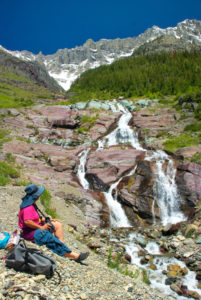
Above Kintla Lake, Glacier National Park, MT. Photo: Doug Schwartz.
What projects excite you lately?
I’ve been fascinated by mushrooms since the 1960s. I’m just starting a new project studying the fungi of the Channel Islands. When I hike around the California Channel Islands, I’m always wondering about the mushrooms there and as far as I know nobody has ever done a thorough study of them and how they relate to the endemic trees and plants. I was at a mushroom conference recently in Salem, Oregon, and I met the president of the North American Mycoflora Prioject. After talking with him and submitting an application, his group came up with the initial funding for me to start a genetic study of the fungi of the Channel Islands. I’m so excited! There are still a lot of hoops to jump through — I need to get permission to collect from the Nature Conservancy and National Park Service — but I might be able to pull it off.
Any final thoughts for our readers?
Exploring the natural history of different parts of the world and contributing to our knowledge of it is something anybody can do and they can do it while they are out having fun. Taking a trip for habitat restoration or for citizen science is just as much fun and much more rewarding than doing a trip for pure pleasure. You’re contributing to better understanding and management of these amazing places, and you’re also getting to explore a bit of the natural world much more closely than anyone else does. To get around a fallen 20-foot thick, 350-foot long redwood trunk in an overgrown old-growth forest with no trail is an adventure. The citizen science stuff and that kind of exploring is amazingly fulfilling and so much fun.
I want to leave people motivated to go out and explore at a deeper level than a simple mountain bike ride down a hill. I hope more people can look and touch and listen to the places they love and learn what’s going on there, whether it’s looking for mushrooms to eat, or studying intertidal life or counting old growth trees. There are so many ways to contribute and give back, but it starts with curiosity and wanting to be engaged. Under every rock that my mountain bike passes by there’s a newt or a salamander, a tarantula or some cool critter. Find a way to get engaged with the places you love. Figure out a way to give back.
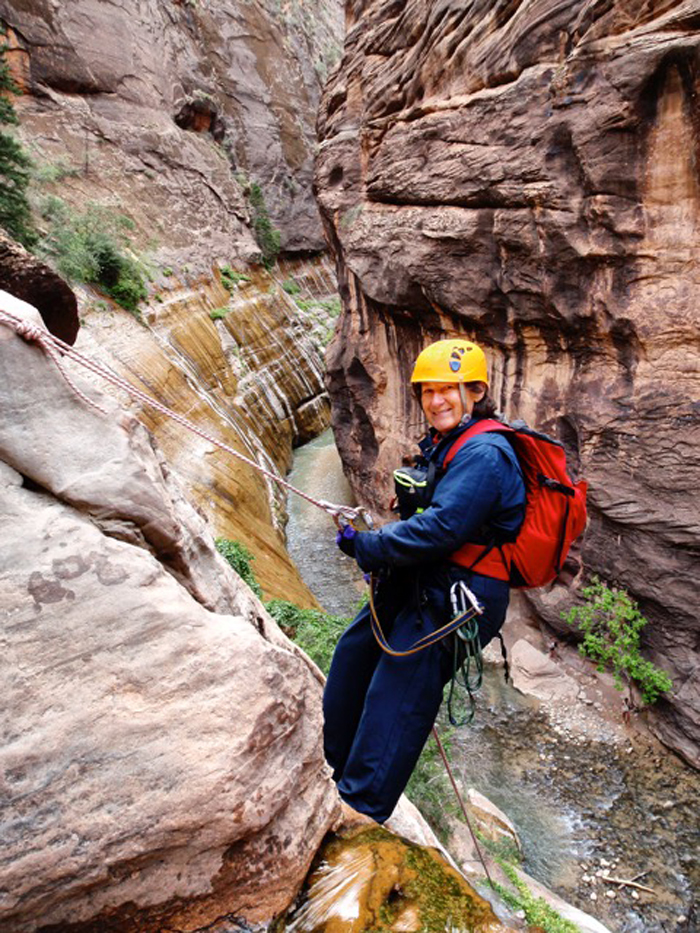
Canyoneering to Virgin River, Zion National Park, UT. Photo: Doug Schwartz.






